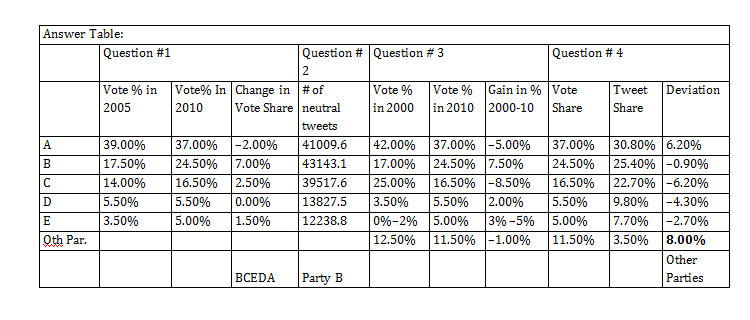Answer questions 1-4 on the basis of information given below:
Twitter allows its users to post/share and read short messages known as tweets. Tweets can be of three types -Positive Tweets (in support), Negative Tweets (against) and Neutral Tweets. The following table presents the Number of Votes and Tweets received by certain political parties.
* Any party which has secured less than 2% of the total votes falls under ‘Other Parties’ category. For example, Party
E secured less than 2% of total votes, in the year 2000.
Note: If the vote share (%age of total votes) of a party changes from 15% to 40%, gain in vote
share would be 25% (= 40% – 15%).
Question 1. Which of the following options correctly arranges the political parties in descending order of gain in vote share from the year 2005 to the year 2010?
A. EBDCA
B. EBCDA
C. EBCAD
D. BCEDA
E. BCEAD
Question 2. Which of the following parties received maximum number of “neutral tweets” in the year 2010?
A. Party B
B. Party C
C. Party D
D. Party E
E. One of the parties categorised under ‘Other Parties’
Question 3. Between 2000 and 2010, in terms of gain in vote share which of the following cannot be a possible value (approximated to one decimal place) for any party?
A. 2.0%
B. 2.5%
C. 3.5%
D. 4.5%
E. 7.5%
Question 4. In 2010, which of the following options has maximum difference between the vote share and tweet share?
A. Party B
B. Party C
C. Party D
D. Party E
E. Other Parties
Answers and Explanations
Solution: Answer Table
Answer 1. (D)
Correct sequence is BCEDA (7%, 2.5%, 1.5%, 0% and negative).
Answer 2. (A)
In Answer Table above, # of Neutral Tweet for any party = Total Tweet x (100% – Positive Tweet – Negative Tweet). Party B got 43143 Tweets i.e. Option A.
Answer 3. (B)
2000 vote percentage for Party E is not given. Thus, maximum vote percentage for Party E can be 2% in 2000 (if it was under the category ‘Other Parties’).
From Answer Table, we can directly conclude that possible values are Option A (for Party D) and Option E (for Party B).
Moreover, this value can be in the range of 3% to 5% for
Party E. So, Options C and D are also possible.
Hence, Option B (2.5% is not possible) is the correct answer.
Answer 4. (E)
It is Other Parties (8%). Refer Answer Table.











